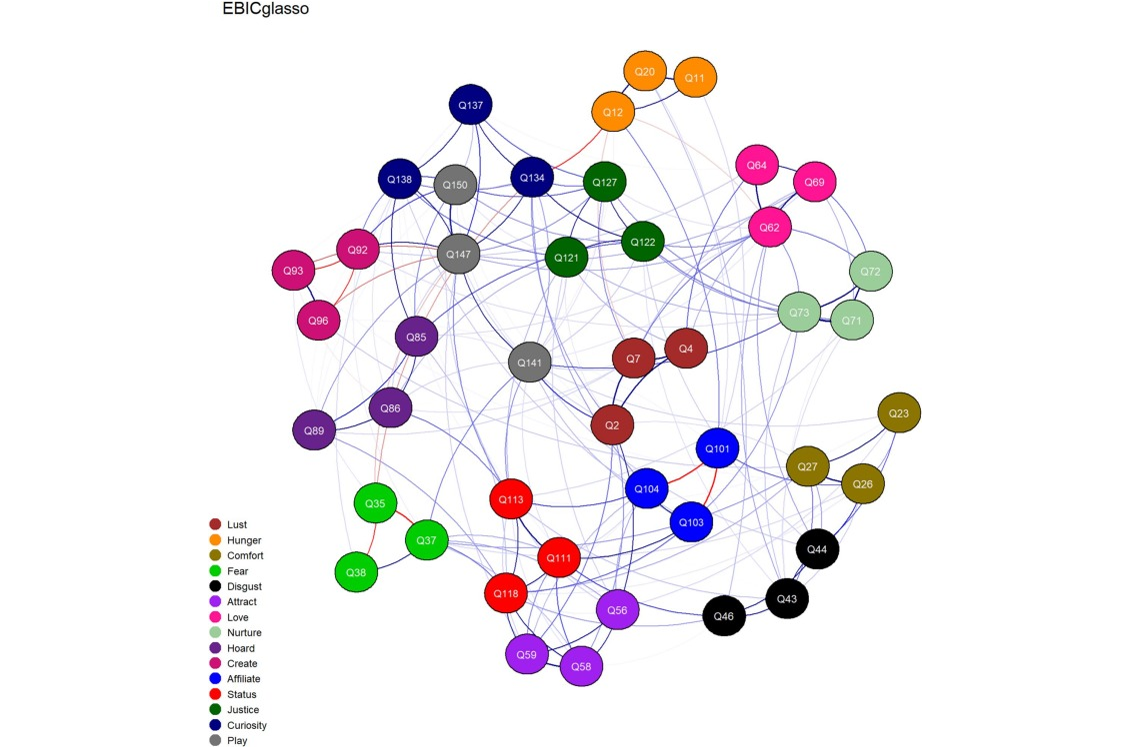Scientists Identify Fifteen Key Motives Driving Human Behaviour

Researchers at HSE University and the London School of Hygiene and Tropical Medicine have identified 15 key motives that drive human behaviour. By analysing people's views, preferences, and actions through an evolutionary lens, they demonstrated how these motives intertwine to shape habits and interpersonal relationships. The findings have been published in Personality and Individual Differences.
The question of what motivates human behaviour has long intrigued psychologists. Various approaches are used to assess these underlying motives. The most well-known theory is Abraham Maslow's hierarchy of needs, introduced in the mid-20th century. However, most approaches emphasise the social aspects of motivation while overlooking its evolutionary underpinnings.
A group of researchers at HSE University and the London School of Hygiene and Tropical Medicine proposed analysing human behaviour motives from an evolutionary perspective. In the proposed framework, all motives are viewed as evolutionary adaptations that enhanced early humans' ability to survive in their environment and continue to influence behaviour today. The scientists proceed from the premise that if certain evolutionary mechanisms once triggered specific behaviours, the underlying motives can be identified using standard psychometric techniques.
To accomplish this, the study authors conducted an online survey with over 500 participants who were asked to rate 150 statements concerning their everyday preferences, fears, desires, and social aspirations. The statements were based on previously identified motives from other studies reflecting physical, reproductive, or social needs, such as 'I enjoy going on roller coasters,' 'Eating is less important to me than it seems to be for most people,' and 'I spend a lot of time staying in touch with my friends,' among others.
Using network analysis, the researchers identified stable clusters of motives. The study found that human behaviour is driven by 15 key motives, which can be grouped into five broad categories: environmental (Hoard, Create), physiological (Fear, Disgust, Hunger, Comfort), reproductive (Lust, Attract, Love, Nurture), psychological (Curiosity, Play), and social (Affiliate, Status, Justice).

The researchers also identified functional relationships between motives, contributing to a deeper understanding of motivational structures. For example, Justice has strong ties to Nurture and Curiosity, suggesting that it is a function of both concern for the welfare of others and a need to keep abreast of where anti-social behaviours might be occurring.
Interestingly, the motives of Play and Status emerged as pivotal points of connectivity, interacting extensively with other nodes, suggesting they influence a broad range of related motives. Status appears to be important as it facilitates the attainment of other goals by providing access to resources that enhance the chances of success in life, including attracting a partner. Maintaining status involves hoarding resources, fearing the loss of these resources, and effectively using them in various situations. The motive of play, in turn, helps develop the skills needed to maintain status and adapt to changing circumstances.
'Using network-based psychometric techniques, we were able to observe how motives interrelate. For instance, the motives of Love and Nurture are positioned close to each other in the network, which makes sense from an evolutionary perspective, as caring for offspring enhances their chances of survival. Conversely, the motives of Fear and Curiosity often have opposing effects. Fear keeps us away from danger, but when excessive, it can suppress curiosity, which fosters knowledge and innovation,' explains Albina Gallyamova, Junior Research Fellow at the HSE Centre for Sociocultural Research.
The study also revealed age- and gender-related variations in the significance of different motives. Women tend to show a greater interest in the motives of Nurture and Comfort, while men are more likely to focus on the motives of Status and Attraction. The researchers note that these differences are linked to the traditional roles men and women played in our evolutionary past.
Age also contributes to shaping our priorities. Younger individuals tend to be more focused on Status and Play, while as people age, Fear and concern for Comfort become more prominent. 'These changes reflect different life stages: initially, we strive to secure our place in society, and later, we focus on safety and survival,' adds Gallyamova.
The study findings can be valuable in various fields, ranging from marketing to IT. For example, in advertising, understanding the motives of different social groups allows for more precise and effective communication. Youth focused on Status and Play are more likely to respond to incentives related to prestige and entertainment, while a more mature audience prioritises safety, reliability, and comfort. In the field of AI, understanding evolutionary motives enables a more human-centred approach, offering gamification and social interaction for younger users, while emphasising convenience and simplicity for the older generation. In therapy, understanding the underlying motives can help provide a more accurate response to the client's needs. For example, addressing anxiety can take into account the evolutionary mechanism of avoiding danger and help strike a balance between safety and curiosity.
'Ultimately, understanding the evolutionary motives that drive our behaviour enables us to create solutions that make people's lives more comfortable, safer, and more interesting,' explains Gallyamova.
See also:
Script Differences Hinder Language Switching in Bilinguals
Researchers at the HSE Centre for Language and Brain used eye-tracking to examine how bilinguals switch between languages in response to context shifts. Script differences were found to slow down this process. When letters appear unfamiliar—such as the Latin alphabet in a Russian-language text—the brain does not immediately switch to the other language, even when the person is aware they are in a bilingual setting. The article has been published in Bilingualism: Language and Cognition.
HSE Experts Highlight Factors Influencing EV Market Growth
According to estimates from HSE University, Moscow leads in the number of charging stations for electric vehicles in Russia, while Nizhny Novgorod ranks first in terms of charging station coverage, with 11.23 electric vehicles per charging station, compared to 14.41 in Moscow. The lack of charging infrastructure is one of the key factors limiting the growth of the electric vehicle market. This is stated in the study titled ‘Socio-Economic Aspects of Introducing Electric Vehicles in Commercial Transportation’ conducted by experts from the Institute of Transport Economics and Transport Policy Studies at HSE University.
Machine Learning Links Two New Genes to Ischemic Stroke
A team of scientists from HSE University and the Kurchatov Institute used machine learning methods to investigate genetic predisposition to stroke. Their analysis of the genomes of over 5,000 people identified 131 genes linked to the risk of ischemic stroke. For two of these genes, the association was found for the first time. The paper has been published in PeerJ Computer Science.
First Digital Adult Reading Test Available on RuStore
HSE University's Centre for Language and Brain has developed the first standardised tool for assessing Russian reading skills in adults—the LexiMetr-A test. The test is now available digitally on the RuStore platform. This application allows for a quick and effective diagnosis of reading disorders, including dyslexia, in people aged 18 and older.
Low-Carbon Exports Reduce CO2 Emissions
Researchers at the HSE Faculty of Economic Sciences and the Federal Research Centre of Coal and Coal Chemistry have found that exporting low-carbon goods contributes to a better environment in Russian regions and helps them reduce greenhouse gas emissions. The study results have been published in R-Economy.
Russian Scientists Assess Dangers of Internal Waves During Underwater Volcanic Eruptions
Mathematicians at HSE University in Nizhny Novgorod and the A.V. Gaponov-Grekhov Institute of Applied Physics of the Russian Academy of Sciences studied internal waves generated in the ocean after the explosive eruption of an underwater volcano. The researchers calculated how the waves vary depending on ocean depth and the radius of the explosion source. It turns out that the strongest wave in the first group does not arrive immediately, but after a significant delay. This data can help predict the consequences of eruptions and enable advance preparation for potential threats. The article has been published in Natural Hazards. The research was carried out with support from the Russian Science Foundation (link in Russian).
Centre for Language and Brain Begins Cooperation with Academy of Sciences of Sakha Republic
HSE University's Centre for Language and Brain and the Academy of Sciences of the Republic of Sakha (Yakutia) have signed a partnership agreement, opening up new opportunities for research on the region's understudied languages and bilingualism. Thanks to modern methods, such as eye tracking and neuroimaging, scientists will be able to answer questions about how bilingualism works at the brain level.
How the Brain Responds to Prices: Scientists Discover Neural Marker for Price Perception
Russian scientists have discovered how the brain makes purchasing decisions. Using electroencephalography (EEG) and magnetoencephalography (MEG), researchers found that the brain responds almost instantly when a product's price deviates from expectations. This response engages brain regions involved in evaluating rewards and learning from past decisions. Thus, perceiving a product's value is not merely a conscious choice but also a function of automatic cognitive mechanisms. The results have been published in Frontiers in Human Neuroscience.
AI Predicts Behaviour of Quantum Systems
Scientists from HSE University, in collaboration with researchers from the University of Southern California, have developed an algorithm that rapidly and accurately predicts the behaviour of quantum systems, from quantum computers to solar panels. This methodology enabled the simulation of processes in the MoS₂ semiconductor and revealed that the movement of charged particles is influenced not only by the number of defects but also by their location. These defects can either slow down or accelerate charge transport, leading to effects that were previously difficult to account for with standard methods. The study has been published in Proceedings of the National Academy of Sciences (PNAS).
Electrical Brain Stimulation Helps Memorise New Words
A team of researchers at HSE University, in collaboration with scientists from Russian and foreign universities, has investigated the impact of electrical brain stimulation on learning new words. The experiment shows that direct current stimulation of language centres—Broca's and Wernicke's areas—can improve and speed up the memorisation of new words. The findings have been published in Neurobiology of Learning and Memory.



